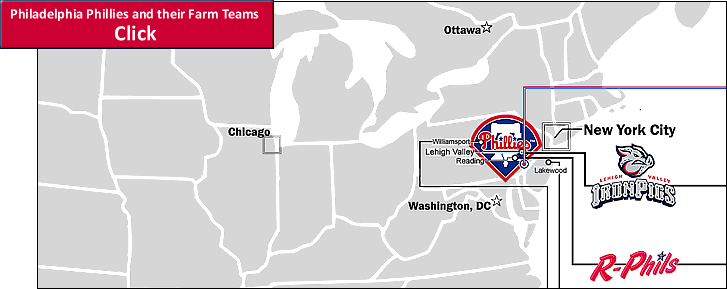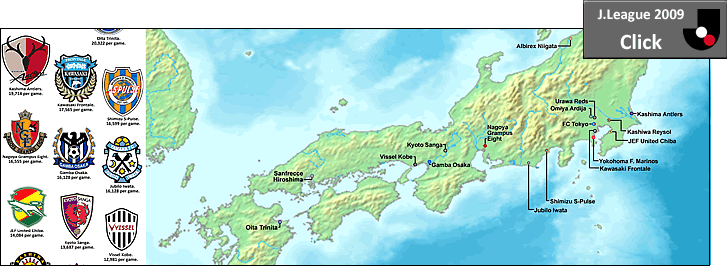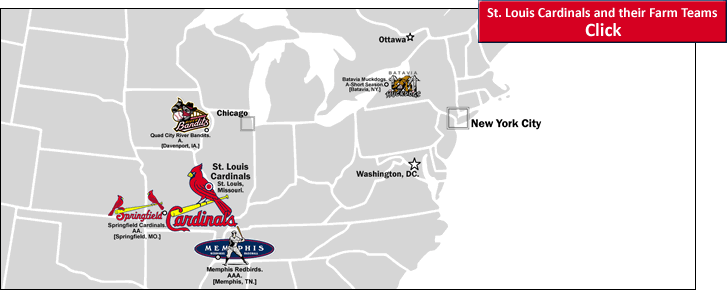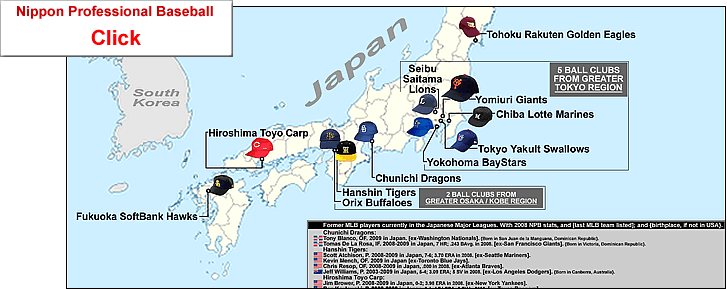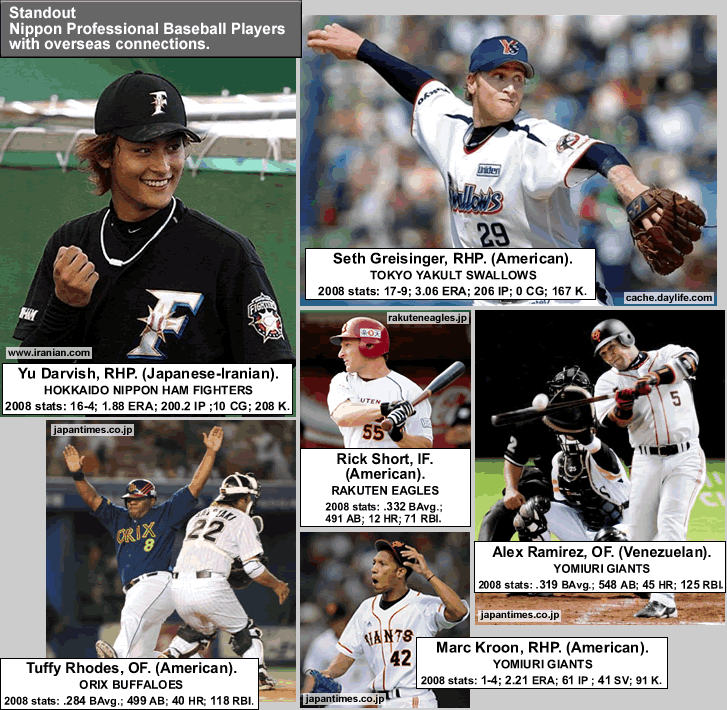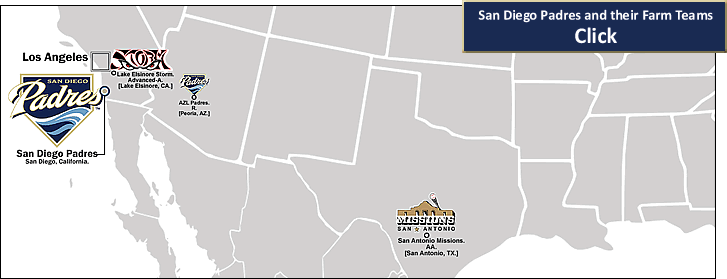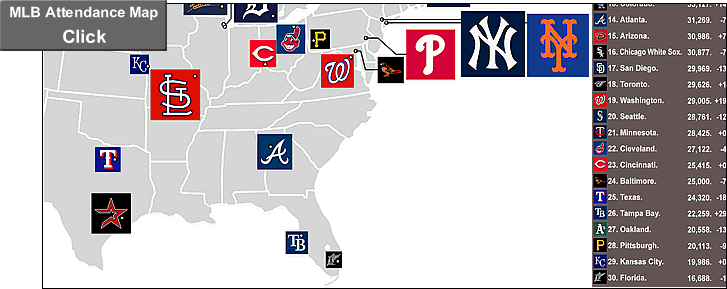
…
…
Please note: to see the most recent MLB paid-attendance map-and-post, click on the following: category: Baseball >paid-attendance.
…
On the map, each MLB team’s 2008 average attendance is listed on the far right. On the map itself, each ball club’s cap crest is sized to reflect their 2008 gate figures. Last season’s overall attendance was the second highest ever, at 32,516 per game, 1.4% behind the record-setting figures of 2007.
Here are the top 5 drawing ball clubs from 2008, and their gate figures from five seasons before, in 2003…
[One note...In 2008, the Boston Red Sox drew to 104.0% capacity, and the Chicago Cubs drew to 99.1% capacity {capacity-based 2008 gate figures , here}. Both these ball clubs have smaller sized parks than the top 5 teams listed below. Of course, much of the charm of Boston's Fenway Park and Chicago's Wrigley Field is just this intimate (and well-aged) atmosphere, so it is sort of pointless to debate whether these two clubs would be pulling in top-5-drawing-ball-club numbers if their parks were bigger. Because if their parks were bigger, the two ball clubs wouldn't be playing in Fenway and Wrigley, but rather in new ball parks, because there is basically no room for significant expansion at both sites. And both the Red Sox and the Cubs would be crazy to move out of these priceless landmarks.]
1. New York Yankees. 2008: 53,069 per game / 2003: 42,785 [1st highest]. I remember going to Yankees games in the early 1990′s, when there would never be more than 25,000 on a weekday game. In 1990 , the Yankees averaged 24,771 per game. After the New York Yankees’ dominance of the 1996-2000 period (with 4 World Series Titles and 4 AL Pennants in 5 years), the crowds swelled. By 2000, the Yankees were averaging 38,193. There followed average gates of 40,811 (2001), 43,323 (2002), 42,263 (2003), 46,609 (2004), 50,502 (2005), 52,445 (2006), and 52,729 (2007).
The Yankees’ on-field failures in the latter part of the last five seasons have not in the least affected their gigantic crowds, but of course the gate figures will go down this season only because the new Yankee Stadium has a smaller capacity. Yankee Stadium (II) seats 52,325, around 4,100 less than the final capacity of the old Yankee Stadium. Compare this to the situation in the late 1980′s and early 1990′s. After the Yankees great run in the late 1970′s and early 1980′s, the organization started spending unwisely on a revolving door of over-the-hill players and/ or players unable to handle the full-glare media presence in New York City. The team underachieved for years, and fans just stopped showing up. People like to be associated with a winner. Of course, the Yankees did make the playoffs every season from 1995 to 2007, and in comparison, the Yankees did not make the playoffs from 1982 to 1994. So even if the team plays in the most populous metropolitan area in the USA, the sparse crowds of the 1980′s and early 1990′s are understandable.
The new stadium probably assures attendances won’t fall off, even if the Yankees continue to fall short of a successsful season…except for one crucial factor. That is the combination of increased ticket prices coming at a time of a severe economic downturn. I guess we’ll see. One thing should be remembered: even in the Yankees’ greatest eras, their attendance was not as good as it has been in the last 12 years.
When Roger Maris hit his 61st home run on the last day of the 1961 season, there were just 23,154 in attendance (the Yankees averaged 21,577 that year, and that was a championship season).
Many call the 1927 Yankees (featuring Babe Ruth, Lou Gehrig, Bob Muesel, and Tony Lazzeri, aka “Murderers’ Row” {see this}) one of the (if not the ) greatest-ever baseball lineups. Average attendance in Yankee Stadium in 1927 ? 15,117 per game {see this, from Baseball-Reference.com}. OK, granted, the bulk of home games then were during working hours, and NYC was far less populous than today. But still.
In 1978, the World Champion Yankees drew merely 28,855 per game en route to their second straight title. The Yankees’ highest gate figures through the 1970′s and 1980′s was in 1980, when the AL Pennant winning Yankees drew 32,437 per game. So when was the Golden Age of Baseball? If you measure that by gate figures, we’re living in it.
Here is Wikipedia’s page on the new Yankee Stadium {click here}.
2. New York Mets. 2008: 51,165 / 2003: 28,406 [16th highest in MLB]. In 2001, the year after the Mets last won the NL Pennant, the ball club drew 32,818 per game. Their average gate then shrunk by over 4,000 to 28,406 by 2003. This was in the bottom half of the league, at 16th highest. But the franchise turned this around mainly by improving their squad… By 2007, with their new crop of players coming into their own and bringing excitement to the dreary, unfriendly and jet-flight-path-cacaphonous confines of Shea Stadium (the place sucked, basically), the crowds for Mets games increased dramatically (41,723 per game in 2006; 47,580 per game in 2007). And two straight seasons of choking in September will not hurt the gate figures this season. Nevertheless, the figures will go down, because like their cross-town rivals, the Mets are moving into a shiny new ball park with a smaller capacity. But it seems to me the Mets made their new park a bit too small. Citi Field will seat just 42,000, which is 15,000 less than Shea Stadium, and 9,165 less than what the Mets drew last season. Maybe it won’t matter, and gate figures will start falling anyways, if the divided-by-cultures (Anglo players vs. Latin players) Mets team continues to meltdown when it matters most. Here is a nice article about how crucial the 2009 season is for the Mets, by ex-Deadspin.com editor Will Leitch, from the March 15, 2009 edition of New York Magazine {click here}.
3. Los Angeles Dodgers. 2008: 46,056 / 2003: 38,748 [4th highest]. A couple years ago, there was talk about how the Angels were starting to challenge the Dodgers for fan-base supremacy in southern California. But the Angels, as improved an organization as they are in the last decade, will probably never outdraw the Dodgers. Dodger Stadium is simply an incredible place. The entire stadium is re-painted every off-season, it is perpetually spic-and-span, and it is home to a ball club with as much tradition, history, and (eventual) success as any in the baseball world. And the voice of the Dodgers is the venerable and mellifluous Vin Scully. My brother told me about a Dodgers blog he came across called Vin Scully Is My Homeboy {click here}, which pretty much answers the question of whether the LA Dodgers will be able to tap into the ever-growing Latino baseball fan market, now that the Angels are owned by a Latin American.
4. St. Louis Cardinals. 2008: 42,353 / 2003: 35,930 [7th highest]. Speaking about first class organizations and huge fan bases, the Cardinals have drawn over 30,000 per game in 21 of their last 24 seasons. In the late 1970′s they were stagnating, though, and drew only 17,101 per game in 1980. The Cardinals won their ninth World Series title two seasons later, in 1982, and drew 26,073 per game that year. By 1985, the NL Pennant winning Cardinals were drawing 32,563 per game. Since then, the only years the ball club has drawn below 30,000 per game were in 1991 and 1992, when they drew in the 29,000′s; and in the strike-shortened 1995 season, when manager Joe Torre was fired midway through the season and the team finished 62-81 (the Cardinals drew 24, 344 per game that year). The next season, 1996, current manager Tony LaRussa took over, and the team’s fortunes and gate figures began their ascent. It is ironic to consider that the Cardinals had their worst recent year at the gate when Joe Torre was in charge, since Torre was the man who managed the Yankees to their last 4 Titles and shepherded the Bronx ball club into their most lucrative period ever.
But getting back to St. Louis…their huge fan base has only gotten bigger after the opening of Busch Stadium (III) in 2006 {see the stadium’s page on Wikipedia, here}, and their surprise World Series title later that year. It was a surprise because that Cardinals team had peaked 2 seasons earlier, and at just 83-78, the 2006 Cardinals squeaked into the playoffs, where they shocked the Mets (who have never recovered) thanks to a late 7th game home run by weak hitting catcher Yadier Molina {recap, here}. The Cardinals, now veterans of the post-season grind, then used that momentum to dismantle the upstart Detroit Tigers in the Fall Classic, 4 games to 1. The 2006 St. Louis Cardinals became the team with the least amount of victories to ever win the World Series; it is their 10th World Series title, second to only the New York Yankees 27 World Series Titles.
5. Philadelphia Phillies. 2008: 42,254 / 2003: 28,973 [14th highest in MLB]. The Phillies went through decades of futility sprinkled with periods of disappointment, with only one World Series title (in 1980) in over 120 years of existence. But last October, they buried a good deal of that negativity by bestowing the city of Philadelphia with it’s first major league sports title in 30 years. There are three factors which contributed to the Philadelphia Phillies’ near-100% capacity gate figures last year. First off, the club has had 7 out of 8 winning seasons since 2001. Secondly, the city has always boasted committed (if ill-mannered) fans. And third, the Phillies moved into a new ball park in 2004 {Citizens Bank Park page at Wikipedia, here}.
The Phillies were drawing in the 30,000′s in the years leading up to their first championship in 1980. But the large crowds fell away as the years went by after that, and the franchise reached a level of mediocrity in a god-awful ugly Veterans Stadium that moldered in it’s concrete-encased, plastic-turf covered gloom. Te hugely entertaining NL Pennant winning Phillies of 1993, led by such colorful characters as John Kruk, Mitch Williams, and Kurt Schilling, produced a two-year spike in gate figures, with the ball club pulling in 38,737 per game in 1993. The next season showed almost the same figures, but by 1997, the ball club was in the basement, and the average gate was only 18,403. The Phillies’ record improved in the years from 1998 to 2003 on a generally uphill progression, and the gate figures improved too, but not drastically, with the high point here being the last year in Veterans Stadium, 2003, with an average crowd of 27,901.
Still that’s not half-bad for a horrible stadium, perhaps the worst of it’s ilk, which was the now-dreaded multi-purpose, circular concrete stadium {see this} {see this, on Veterans Stadium, from BallParksOfBaseball.com site}. City planners thought they were pretty smart, building stadiums for both their MLB and NFL teams. What they didn’t really look into was the fact that these stadiums were doomed to be lousy venues for both sports.
These monstrosities plagued Major League Baseball throughout the 1960′s, the 1970′s, the 1980′s, and into the mid-1990′s. There is little doubt, in retrospect, that this type of stadium began depressing baseball attendance figures by the mid 1980′s, when these stadiums began to age in a rather ungraceful way, and baseball fans began wondering why they weren’t being allowed to see their city skylines hidden behind a wall of usually empty outfield seats. So much of the whole attraction of going to a ball game is the unique aspect of each ballpark, a factor which was eliminated by these multi-purpose behemoths. Sight lines were bad, and the seats were invariably too far away from the action on the field. And they were freaking ugly. In the multi-purpose heyday, circa 1985 or so, about 40% of MLB cities were afflicted by these concrete purgatories…San Francisco, Oakland, San Diego, Seattle, Houston, St. Louis, Minneapolis, Cincinnati, Pittsburgh, Atlanta, Montreal, and New York (the Mets’ Shea Stadium). The only two that remain are the Minnesota Twins’ Metrodome, and the Oakland Athletics’ Oakland-Alameda County Stadium; and the Twins will be moving into a new, suitably retro-themed open-air ballpark called Target Field, next year {see this}.
Oakland’s situation, though, is fraught with difficulties. When the NFL’s Raiders moved back to Oakland from Los Angeles (in 1995), the stadium got a Frankenstein makeover that left the Athletics fans behind home plate having to stare at a Death-Star-like structure looming behind center field, a sheer wall of nose-beed football seats that was soon dubbed “Mount Davis”, after the Raiders’ Mephistophelian owner, Al Davis {see this}. Something tells me this issue will never go away, and the A’s will have to move to Sacramento or Las Vegas, or learn to live with Mount Davis.
-
All baseball fans owe a huge debt to the Baltimore Orioles organization of the early 1990′s, which oversaw the creation of the trailblazing Oriole Park at Camden Yards {see the ball park’s page at Wikipedia, here}. Since then 11 MLB franchises have followed suit by building similar asymetrical ballparks which a) maintain a traditional feel, while b) being coupled with modern amenities {see this list}. And which have nothing to do with the damn NFL.
Thanks to ESPN for the attendance figures {click here}. Thanks to Baseball-Reference.com for attendance figures from earlier seasons {click here (set at 1990)}. Thanks to the contributors to the pages at Wikipedia {MLB page, here}

